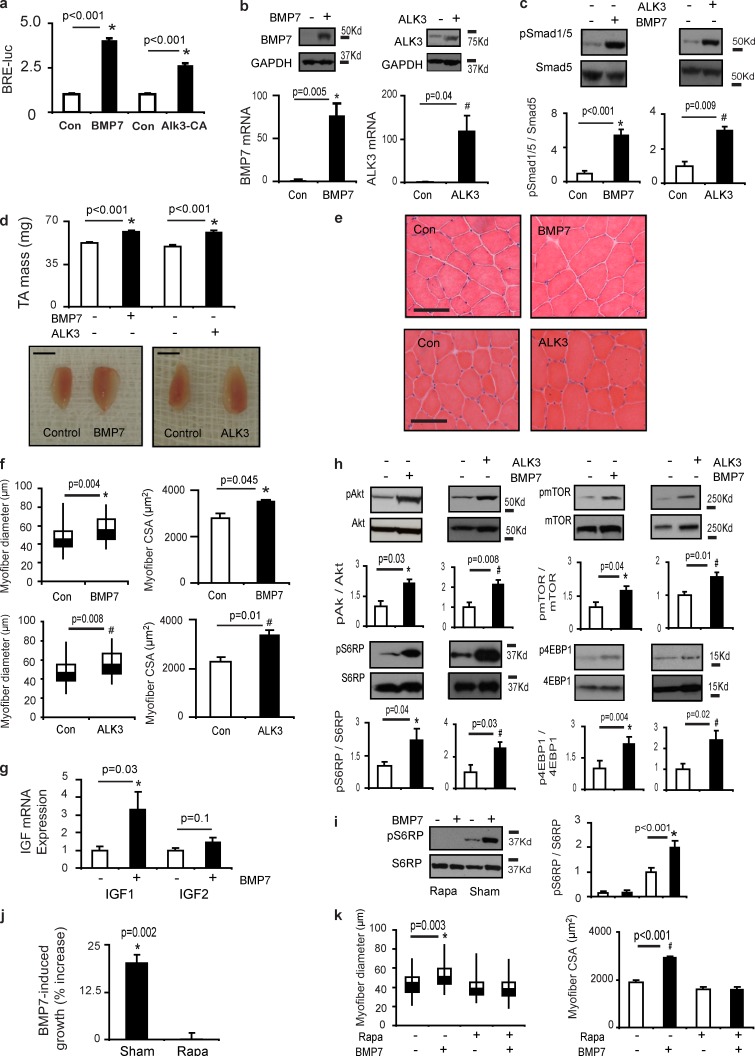Figure 1.
Postnatal expression of BMP7 and ALK3 promotes skeletal muscle hypertrophy. (a) Plasmids expressing BMP7 or constitutively active type-IA BMP receptor (ALK3) were transfected into C2C12 cells along with plasmids expressing a BMP luciferase reporter and β-galactosidase 48 h before examination (*, P < 0.001 vs. control). Figure represents three independent experiments, with each individual experiment performed in triplicate. (b) The administration of rAAV6:BMP7 or rAAV6:ALK3 to mouse limb muscles resulted in significant increases in BMP7 (n = 4 per treatment) and ALK3 (n = 4 per treatment) protein and gene expression, respectively, when examined 28 d after injection (*, P = 0.005 vs. control; #, P = 0.04 vs. control). (c) rAAV6:BMP7 (n = 4 per treatment) and rAAV6:ALK3 (n = 4 per treatment) significantly increased the phosphorylation of Smad1/5S463/465 (*, P < 0.001 vs. control; #, P = 0.009 vs. control). (d) Injection of the anterior musculature of the mouse hindlimb with rAAV6:BMP7 (n = 11) or rAAV6:ALK3 (n = 4 per treatment) increased muscle mass by ∼25% (*, P < 0.001 vs. control). Bars, 5 mm. (e and f) Muscle hypertrophy was a product of increased muscle fiber size as demonstrated by representative H&E-stained cryosections and quantification of myofiber diameter (represented as box and whisker plots comprising minimum, lower quartile, median, upper quartile, and maximum values for myofiber diameter; *, P = 0.004 vs. control; #, P = 0.008 vs. control) and myofiber area (*, P = 0.045 vs. control; #, P = 0.01 vs. control; n = 3 per treatment). Bars, 100 µm. (g) IGF1 and IGF2 mRNA expression was determined 28 d after rAAV6:BMP7 administration (*, P = 0.03 vs. control; n = 7–9 per treatment). (h) Muscles examined 28 d after injection of rAAV6:BMP7 (n = 5–8 per treatment) or rAAV6:ALK3 (n = 4–11 per treatment) demonstrated significant increases in phosphorylation of AktS473 (*, P = 0.03 vs. control; #, P = 0.008 vs. control), mTORS2448 (*, P = 0.04 vs. control; #, P = 0.01 vs. control), S6RPS235/236 (*, P = 0.04 vs. control; #, P = 0.03 vs. control), and 4EBP1T37/46 (*, P = 0.004 vs. control; #, P = 0.02 vs. control). (i) When administered at 1 mg/kg/day, rapamycin attenuated BMP7-induced phosphorylation of S6RPS235/236 when compared with muscles expressing BMP7 that were collected with animals receiving vehicle (*, P < 0.001 vs. control; n = 4–5 per treatment). (j) Intraperitoneal injections of rapamycin for 28 d completely prevented the ability of BMP7 (n = 5–7 per treatment) to induce skeletal muscle growth. The muscle hypertrophy induced by BMP7 is presented as a percentage increase in the presence of either sham or rapamycin (*, P = 0.002 vs. control). (k) Increases in myofiber diameter and area typically observed in muscles examined 28 d after injection of rAAV6:BMP7 were prevented by coadministration of rapamycin (*, P = 0.003 vs. control; #, P < 0.001 vs. control; n = 3 per treatment). Data for myofiber diameter are presented as box and whisker plots comprising minimum, lower quartile, median, upper quartile, and maximum values. Data are presented as means ± SEM.

